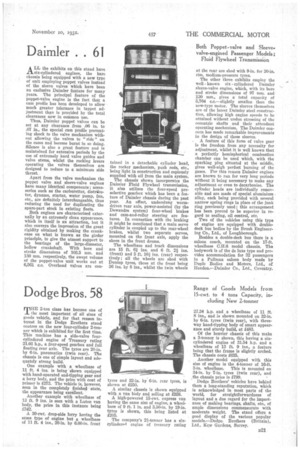Daimler . . 61
Page 11

If you've noticed an error in this article please click here to report it so we can fix it.
ALL the exhibits on this stand have six-cylindered engines, the bare chassis being equipped with a new type of unit employing poppet valves instead of the sleeve valves which have been an exclusive Daimler feature for many years. The principal feature of the poppet-valve engine is the fact that a cam profile has been developed to allow• much greater tolerance in tappet adjustment than is provided by the total clearances now in common use.
Thus, Daimler poppet valves can be set at any clearance from .06 in. to .07 in., the special cam profile preventing shock to the valve mechanism without allowing the valves to " ride " on the cams and become burnt in so doing. Silence is also a great feature and is maintained for extensive periods by the use of extremely hard valve guides and valve stems, whilst the rocking levers operating the valves themselves are designed to reduce to a minimum side thrust, Apart from the valve mechanism the poppet valve and sleeve-valve engines have many identical components ; accessories such as the carburetter, distributor, dynamo, starter, water pump, fan, etc., are definitely interchangeable, thus reducing the need for duplicating the spare-part stock in existing fleets.
Both engines are characterized externally by an extremely clean appearance, which in itself is an attraction, but it also conveys the impression of the great rigidity obtained by making the crankcase on what is known as the girder principle, to give the utmost support to the bearings of the large-diameter, hollow crankshaft. With bore and stroke dimensions of 103.5 mm. and 130 mm. respectively, the swept volume of the poppet-valve unit works out at 6,561 c.c. Overhead valves are con tamed in a detachable cylinder head, the rocker mechanism, push rods, etc., being light in construction and copiously supplied with oil from the main system.
The chassis shown incorporates the Daimler Fluid Flywheel transmission, it also utilizes the four-speed preselective gearbox which has been a feature of Daimler chassis during the past year. An offset, underslung wormdriven rear axle, power-assisted (by the Dewandre system) four-wheel brakes and cam-and-roller steering are features. In connection with the braking it might be mentioned that a main servo cylinder is coupled up to the rear-wheel brakes, whilst two separate servos, mounted on the front axle, apply the shoes in the front drums.
The wheelbase and track dimensions are 15 ft. 61 ins. and 6 ft. 21 ins. (front) and 5 ft. 101 ins. (rear) respectively; all the wheels are shod with Dunlop tyres, those at the front being 36 ins. by 8 ins., whilst the twin wheels
at the rear are shod with 9-in. for 20-in. rim, medium-pressure tyres.
The other three exhibits employ the well known six cylindered Daimler sleeve-valve engine, which, with its bore and stroke dimensions of 97 mm. and 130 mm., gives a total capacity of 5,764 c.c.—slightly smaller than the new-type motor. The sleeves themselves are of the latest Daimler steel construction, allowing high engine speeds to be attained without undue stressing of the eccentric shafts and their attendant operating mechanism. The Daimler concern has made remarkable improvements in the design of these sleeves.
A feature of this form of valve gear is the freedom from any necessity for adjustment, whilst it is well known that a perfectly hemispherical combustion chamber can be used which, with the sparking plug situated at the middle, gives well-nigh perfect burning of the gases. For this reason Daimler engines are known to run for very long periods without it being necessary to make any adjustment or even to decarbonize. The cylinder heads are individually removable and are made of special aluminium . alloy, each being provided with several narrow spring rings in place of the junk ring previously used ; this arrangement has been proved to be superior in regard to sealing, oil control, etc.
Two of the vehicles using this type of engine are equipped with doubledeck bus bodies by the Brush Engineering Co., Ltd., of Loughborough.
Besides a double-deck bus there is a saloon coach, mounted on the 17-ft. wheelbase C.E.6 model chassis, The body-work is of the de luxe type and provides accommodation for 32 passengers in a Pullman saloon body made by Duple Bodies and Motors, Ltd., of Hendon.—Daimler Co., Ltd., Coventry.
















































































































































